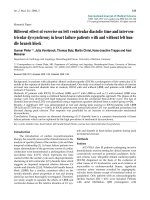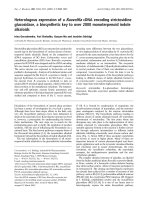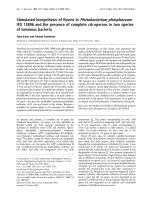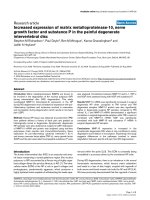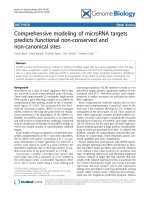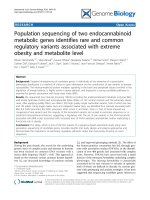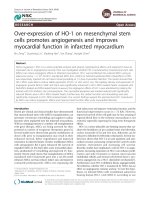Báo cáo y học: "ntravenous transplantation of allogeneic bone marrow mesenchymal stem cells and its directional migration to the necrotic femoral head"
Bạn đang xem bản rút gọn của tài liệu. Xem và tải ngay bản đầy đủ của tài liệu tại đây (1.26 MB, 10 trang )
Int. J. Med. Sci. 2011, 8
74
I
I
n
n
t
t
e
e
r
r
n
n
a
a
t
t
i
i
o
o
n
n
a
a
l
l
J
J
o
o
u
u
r
r
n
n
a
a
l
l
o
o
f
f
M
M
e
e
d
d
i
i
c
c
a
a
l
l
S
S
c
c
i
i
e
e
n
n
c
c
e
e
s
s
2011; 8(1):74-83
© Ivyspring International Publisher. All rights reserved.
Research Paper
Intravenous transplantation of allogeneic bone marrow mesenchymal
stem cells and its directional migration to the necrotic femoral head
Zhang-hua Li
1*
, Wen Liao
2*
, Xi-long Cui
1
, Qiang Zhao
3
, Ming Liu
1
, You-hao Chen
1
, Tian-shu Liu
1
,
Nong-le Liu
3
, Fang Wang
3
, Yang Yi
4
, Ning-sheng Shao
3
1. Department of Orthopaedics, Renmin Hospital of Wuhan University, Wuhan 430060, China.
2. Department of Orthopedics, Affiliated Hospital of Hebei University, Baoding 071000, China.
3. Laboratory of Biochemistry and Molecular Biology, Institute of Basic Medical Sciences, Academy of Military Medical
Sciences, Beijing 100850, China.
4. College of Health Science, Wuhan Institute of Physical Education, Wuhan 430079, China.
*
Zhang-hua Li and Wen Liao contributed equally to this work.
Corresponding author: Zhang-hua Li, Tel: +8627-88041911-82209; Email:
Received: 2010.08.11; Accepted: 2011.01.01; Published: 2011.01.09
Abstract
In this study, we investigated the feasibility and safety of intravenous transplantation of al-
logeneic bone marrow mesenchymal stem cells (MSCs) for femoral head repair, and observed
the migration and distribution of MSCs in hosts. MSCs were labeled with green fluorescent
protein (GFP) in vitro and injected into nude mice via vena caudalis, and the distribution of
MSCs was dynamically monitored at 0, 6, 24, 48, 72 and 96 h after transplantation. Two weeks
after the establishment of a rabbit model of femoral head necrosis, GFP labeled MSCs were
injected into these rabbits via ear vein, immunological rejection and graft versus host disease
were observed and necrotic and normal femoral heads, bone marrows, lungs, and livers were
harvested at 2, 4 and 6 w after transplantation. The sections of these tissues were observed
under fluorescent microscope. More than 70 % MSCs were successfully labeled with GFP at
72 h after labeling. MSCs were uniformly distributed in multiple organs and tissues including
brain, lungs, heart, kidneys, intestine and bilateral hip joints of nude mice. In rabbits, at 6 w
after intravenous transplantation, GFP labeled MSCs were noted in the lungs, liver, bone
marrow and normal and necrotic femoral heads of rabbits, and the number of MSCs in bone
marrow was higher than that in the, femoral head, liver and lungs. Furthermore, the number
of MSCs peaked at 6 w after transplantation. Moreover, no immunological rejection and graft
versus host disease were found after transplantation in rabbits. Our results revealed intra-
venously implanted MSCs could migrate into the femoral head of hosts, and especially migrate
directionally and survive in the necrotic femoral heads. Thus, it is feasible and safe to treat
femoral head necrosis by intravenous transplantation of allogeneic MSCs.
Key words: femoral head necrosis; bone marrow mesenchymal stem cell; migration; safety
Introduction
Recently, stem cell transplantation has been a
focus in the treatment of some diseases. Stem cells
have the potential of multi-directional differentia-
tions, and they can differentiate into specialized cells
to repair injured tissues under certain conditions [1].
Animal experiments have demonstrated that in an-
oxic environment, implanted stem cells can differen-
tiate and promote neovascularization which effec-
tively increase the blood perfusion in ischemic tissues,
and thus inhibit further necrosis of tissues [2,3]. Re-
Int. J. Med. Sci. 2011, 8
75
searchers have transplanted the bone marrow stem
cells into the necrotic femoral heads, and results show
bone marrow stem cells can remove vascular lesions
and promote angiogenesis in necrotic femoral heads,
accompanied by significant improvement of blood
circulation in the necrotic femoral head and sur-
rounding tissues [4]. Mesenchymal stem cells (MSCs)
are multipotent stem cells that can differentiate into a
variety of cell types. In the field of cell transplantation,
MSCs have many advantages over other cell types
such as easy isolation and culture, rapid in vitro am-
plification, differentiation potential, and easy collec-
tion [2]. Currently, MSCs have been applied in the
treatment of femoral head necrosis. Experiments
demonstrate the implanted MSCs can not only sur-
vive but proliferate in the necrotic femoral head after
transplantation, promoting the repair of injured fem-
oral head [5]. In addition, intravenously implanted
MSCs can migrate into and repair the injured tissues
[6,7]. Thus, allogeneic transplantation of MSCs
through intravenous injection may be a minimally
invasive strategy for the treatment of femoral head
necrosis. In this study, green fluorescent protein
(GFP) labeled allogeneic MSCs were intravenously
injected into nude mice and the distribution and mi-
gration of MSCs were dynamically monitored to
evaluate the feasibility and safety of intravenous im-
plantation of allogeneic MSCs in the treatment of
femoral head necrosis. Our study may provide theo-
retical basis for the clinical application of MSCs.
Materials and methods
Reagents and instruments
In the present study, L-DMEM medium, fetal
bovine serum (Hyclone, USA), Percoll separating
medium (Sigma, USA), Kodak DXS small animal im-
aging system and adenovirus vector carrying GFP
(Adeasy GFP) were used. The adenovirus vector car-
rying GFP was kindly provided by Professor Zhou
(Peking University, China).
Experimental animals
A total of 12 male rabbits (6 months old) weigh-
ing 2.5 ± 0.5 kg and 18 nude mice (6 weeks old)
weighing 15-20 g were purchased from the Experi-
mental Animal Center, Academy of Military Medical
Sciences, China. This study was approved by the
Ethics Committee of our university.
Amplification and purification of Adeno-GFP
recombinant adenovirus vector
Adeno-GFP infected HEK293 cells and their ly-
sate were harvested when cytopathogenic effects ap-
peared. After three freeze-thaw cycles, solution was
centrifuged at 14000 g for 10 min, and viruses were
harvested from the supernatant. Viruses were puri-
fied by cesium chloride density gradient centrifuga-
tion, and virus titer was determined after the for-
mation of virus negative colonies. Virus vectors were
preserved at -80 ºC.
Isolation, purification, culture and identification
of rabbit MSCs
Heparin anti-coagulated bone marrow was col-
lected from the rabbit right proximal tibia under ster-
ile conditions. MSCs were isolated by density gradi-
ent centrifugation with Percoll. Then, these cells were
re-suspended in L-DMEM culture medium containing
10% fetal bovine serum, 100 U/ml streptomycin and
100 U/ml penicillinum at a density of 2.0×10
5
/cm
2
and incubated in 25 cm
2
flasks at 37 ºC in humidified
atmosphere with 5% CO
2
. After 3 days of culture, the
medium was refreshed, and then the medium
changed every other day. Cell passaging was per-
formed when cell confluence reached 85%. The purity
and immunophenotype of MSCs and their potentials
of osteogenesis and adipogenesis were determined.
Femoral head necrosis animal model
The rabbit model of femoral head necrosis was
established according to previously reported [8].
Weight loading area of femoral heads was exposed
and treated with liquid nitrogen for 3-5 min until the
articular cartilage of femoral head became pale. Im-
mediately, femoral head was re-warmed with normal
saline at 37 ºC for 3 min. Then, the wound was closed
and covered with sterile dressing, and 800 000 U of
penicillin were intramuscularly administered for each
rabbit immediately followed by 400 000 U of penicillin
daily for consecutive 5 days.
Cell labeling and transplantation
In order to observe the distribution of implanted
MSCs in vivo, MSCs were labeled with GFP in vitro
before transplantation [9]. In brief, the solution con-
taining GFP was added to MSCs followed by incuba-
tion for 6 h. Then, low glucose DMEM containing 10%
serum of equal volume was added followed by incu-
bation for 72 h. The transfection efficiency was de-
tected under a fluorescence microscope. A total of
5×10
5
GFP-labeled MSCs (about in 300 μl of cell sus-
pension) were injected into nude mice through vena
caudalis. At 0, 6, 24, 48, 72 and 96 h after transplanta-
tion, the nude mice were anesthetized and placed in a
supine position. The in vivo GFP-labeled MSCs were
dynamically monitored in a Kodak DXS small animal
imaging system [10]. When, the anesthetized nude
mice were placed on the platform, the background
image was taken under the lights of an illuminator.
Int. J. Med. Sci. 2011, 8
76
Then, the illuminator was turned off, and the image of
light emitted from the nude mice, namely biolumi-
nescence image, was taken. Then, two images were
merged and the location of light source was shown in
mice.
At 2 w after femoral head necrosis, 5×10
7
GFP-labeled MSCs (about in 3 ml of cell solution)
were injected into rabbits through the ear vein, within
more than 1 min. Necrotic and normal femoral heads,
bone marrows, lungs and livers were harvested at 2, 4
and 6 w after transplantation and sectioned followed
by observation under a fluorescent microscope. At 24
h, 72 h, 1 w, 4 w and 6 w after transplantation, the
manifestations of immunological rejection and graft
versus host disease were monitored.
Statistical analysis
Three sections were used for analysis. Five fields
from each section were randomly selected and GFP
positive cells were counted at a magnification of 200.
Data were expressed as means ± standard deviation
(SD). Statistical analysis was performed with SAS6.12
statistic software package and Student t test was car-
ried out for comparisons. A value of P<0.05 was con-
sidered statistically significant.
Results
Observation of immunological rejection and
graft versus host disease
During the experiment, all animals survived.
There were no significant changes in the heart rate,
breath rate, body temperature, mental condition, uri-
nation, and defecation. Routine blood tests and tests
of liver or renal functions showed normal. No acute or
chronic toxicity and manifestations of graft versus
host disease were observed. Besides, no swelling at
injection sites and lower limb movement disorder
were noted.
Isolation, culture, identification and GFP labeling
of MSCs
At early stage, rabbit MSCs were long spin-
dle-shaped and fibroblast-like, and arranged paral-
lelly. Subsequently, a majority of MSCs gradually
presented whirl-like growth (Figure 1A), and a small
amount of rabbit MSCs were polygonal. After
Adeno-GFP infection, the morphology, and prolifera-
tion of cells were not significantly changed (Figure 2).
At 24 h after infection, scattered green fluorescence
was observed under fluorescence microscope and
bright green fluorescent observed at 72 h after infec-
tion (Figure 1B). The infection rate was over 70%.
Flow cytometry showed the MSCs had no ex-
pressions of CD34, CD45 and HLA-DR, but high ex-
pressions of CD29 and CD44. Furthermore, the purity
of cells with these phenotypes was as high as 99%
which suggested the homogeneous phenotype. After
adipogenesis induction for 1 week, oil red O staining
showed lipid droplets in the MSCs. After osteogenesis
induction for 1 week, alkaline phosphatase staining
showed positive cells, and 3 weeks after osteogenesis
induction, bone nodule was present demonstrated by
VonKossa staining (Figure 3 A, B, C).
Figure 1 MSCs after isolated culture. a: MSCs of passage 3 under a light microscope (×100); b: MSCs labeled with GFP under
fluorescent microscope(×100).
Int. J. Med. Sci. 2011, 8
77
Figure 2 Cell proliferation curve. The proliferation of Adeno-GFP infected MSCs was similar to that of normal MSCs.
Figure 3 Induction of osteogenesis and adipogenesis of MSCs (×100). A: One week after osteogenesis induction, alkaline
phosphatase staining showed positive cells. B: One week after adipogenesis induction, oil red O staining showed lipid droplets
in the MSCs. C: Three weeks after osteogenesis induction, bone nodule was present demonstrated by VonKossa staining.
Distribution of MSCs in vivo
Kodak DXS small animal imaging system is a
real-time imaging system which can be used to ob-
serve the distribution of cells in living animals in a
real time pattern. In the imaging system, GFP fluo-
rescence presented bright white. Most implanted
MSCs concentrated in the tail of nude mice immedi-
ately after transplantation, and a small amount of
MSCs were distributed in the right hip joint. Subse-
quently, MSCs migrated into almost all organs, and
were uniformly distributed in the brain, lungs, heart,
kidney, intestine, hip joints and other organs at 24 h
after transplantation. At 48 h after transplantation, the
amount of MSCs in tissues gradually decreased, and
nearly no GFP fluorescence was observed in nude
mice at 96 h after transplantation. These findings in-
dicate that intravenously injected MSC could migrate
into the femoral head and stayed in the femoral head
for a relatively long time (Figure 4 A-F).
Gross presentations of femoral head
The surface of normal femoral head was smooth
and round, and the articular cartilage was transparent
and glossy (Figure 5A). After surgery, the shape of
femoral head was not markedly changed and the
surface of femoral head was pale and dull without
normal glossiness and smoothness. The transparency
was decreased (Figure 5B). At 6 w after MSC trans-
plantation, the shape of femoral head was integrity
and the articular cartilage largely preserved. The ar-
ticular cartilage was glossy and smooth, a fraction of
which present dark red (Figure 5C).
Distribution of GFP positive cells in nude mice
After blue excitation light was absorbed, GFP
presented green fluorescence. At 6 h after intravenous
allogeneic MSC implantation, GFP-labeled MSCs
were observed in the lungs, liver, bone marrow and
normal femoral head, and the amount of GFP positive
0
0.05
0.1
0.15
0.2
2 4 6 8 10 12 14
day
A value
normal MSCs
MSCs after
GFP labeling
Int. J. Med. Sci. 2011, 8
78
MSCs in the bone marrow was higher than that in the
liver, lungs and femoral head. There were also a lot of
GFP labeled MSCs in the necrotic region of femoral
head at different time points, and the number of cells
presenting green fluorescence reached a maximal
level at 6 w after transplantation, indicating that in-
travenously implanted GFP-labeled MSCs can mi-
grate into multiple tissues with circulation of blood
flow. MSCs could directionally migrate into and sur-
vive in the necrotic area of femoral heads (Table 1 and
Figure 6).
Figure 4. In vivo migration of MSCs after transplantation. A: immediately after intravenous MSCs transplantation; B: 6 h after
MSCs transplantation; C: 24 h after MSCs transplantation; D: 48 h after MSCs transplantation; E: 72 h after MSCs trans-
plantation; F: 96 h after MSCs transplantation.
Figure 5 Gross presentations of normal and necrotic femoral heads. A: Femoral head before necrosis; B: Femoral head
immediately after necrosis; C: Femoral head at 6 w after MSCs transplantation. Black arrow shows the surface of femoral
head. The normal femoral head was smooth and round, and the articular cartilage was transparent and glossy (A). After
freezing, the femoral head was pale in the absence of normal glossiness and smoothness (B). A fraction of articular cartilage
was dark red (C).


